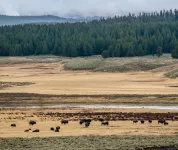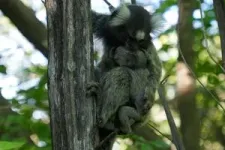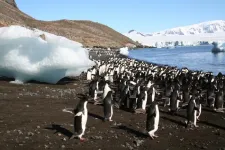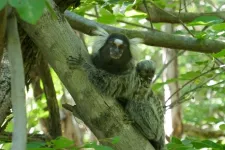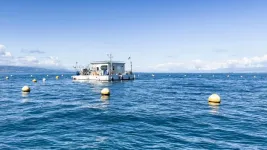(Press-News.org) Large herbivores like bison or elk have continuously lived in the Yellowstone National Park region for about 2,300 years according to a new analysis of chemicals preserved in lake sediments. John Wendt of Oklahoma State University, U.S., and colleagues present these findings in the open-access journal PLOS ONE on October 30, 2024.
The near-extinction of bison in North America in the 19th and 20th centuries was a major ecological catastrophe and little is known about where and how these animals lived before European colonization. In the new study, researchers attempted to determine the dominant large herbivores that lived in the northern Yellowstone National Park area by analyzing steroids from animal dung in lake sediments dating from about 238 B.C. to the present time.
To perform this analysis, researchers first determined which types of steroids occur in the dung of several large herbivores believed to have lived in the region, including bison, elk, moose, mule deer and pronghorn. They found they could identify moose, pronghorn and mule deer based on the steroids in their dung alone, but that bison and elk were harder to differentiate from each other. When the researchers analyzed steroids from different layers of lake sediments, they saw that either bison, elk or a combination of the two, were the primary large herbivore species in the watershed for the last 2,300 years.
The analysis also showed high steroid levels in the 20th century, a time when hunting was banned, bison and elk were discouraged from migrating in winter, and their natural predators were eliminated. Based on the levels of plant pollen, microalgae or plankton detected in these sediments, the researchers concluded that the expanded animal populations likely ate up local forage plants, like willow and Idaho fescue, and that their dung may have fertilized the growth of diatoms in the lake, changing the local ecosystem. Provisions of winter hay in nearby meadows, provided by park managers, also kept animals in the area for longer, resulting in impacts to the watershed.
The new research demonstrates that the analysis of steroids from lake sediments is a promising tool that can help wildlife managers and conservationists understand how communities of hoofed animals and their impacts have shifted over time. While the results shed light on historical changes within a single watershed, researchers expect that extending this approach to a network of sites could provide much-needed information on past grazing animal communities at Yellowstone National Park and beyond.
The authors add: “We developed a 2,300-year record of wild herbivore activity in northern Yellowstone National Park with fossil biomarkers found in lake sediments. This information is critical for understanding long-term dynamics of ecologically and culturally important herbivores such as bison and elk.”
#####
In your coverage please use this URL to provide access to the freely available article in PLOS ONE: https://journals.plos.org/plosone/article?id=10.1371/journal.pone.0311950
Citation: Wendt JAF, Argiriadis E, Whitlock C, Bortolini M, Battistel D, McWethy DB (2024) A 2000-year record of fecal biomarkers reveals past herbivore presence and impacts in a catchment in northern Yellowstone National Park, USA. PLoS ONE 19(10): e0311950. https://doi.org/10.1371/journal.pone.0311950
Author Countries: U.S.A., Italy
Funding: We acknowledge funding from the American Museum of Natural History to J.A.F.W. (www.amnh.org/research/richard-gilder-graduate-school), Montana Institute on Ecosystems to J.A.F.W and D.B.M. (www.montana.edu/ioe), and the National Science Foundation grant EAR-2149482 to C.W. and D.B.M (www.nsf.gov). The funders had no role in study design, data collection and analysis, decision to publish, or preparation of the manuscript.
END
Large herbivores have lived in Yellowstone National Park for more than 2,000 years
Chemicals from dung buried in lake sediments reveal their presence and ecological impacts
2024-10-30
ELSE PRESS RELEASES FROM THIS DATE:
Antarctic penguin colonies can be identified and tracked from tourists' photos, using a computer model to reconstruct the 3D scene
2024-10-30
Antarctic penguin colonies can be identified and tracked from tourists' photos, using a computer model to reconstruct the 3D scene
###
Article URL: https://journals.plos.org/plosone/article?id=10.1371/journal.pone.0311038
Article Title: Penguin colony georegistration using camera pose estimation and phototourism
Author Countries: U.S.A.
Funding: This work was supported in part by the NASA Biodiversity Program (Award 317 80NSSC21K1027), and NSF Grant IIS-2212046. The funders had no say in the study design, data collection and analysis, decision to publish, or preparation of the manuscript. END ...
For patients with alcohol use disorder, exercise not only reduces alcohol dependence, but also improves mental and physical health, per systematic review
2024-10-30
For patients with alcohol use disorder, exercise not only reduces alcohol dependence, but also improves mental and physical health, per systematic review
###
Article URL: https://journals.plos.org/plosone/article?id=10.1371/journal.pone.0311166
Article Title: Effectiveness of exercise intervention in improving physical and mental status of patients with alcohol use disorders: A systematic review and meta-analysis
Author Countries: China
Funding: This study was funded by a grant from the National ...
Bones from Tudor Mary Rose shipwreck suggest handedness might affect collarbone chemistry
2024-10-30
Editor's Note: Please do not include the image originally uploaded with this release in any of your coverage as the licensing information has now changed. Please contact onepress@plos.org for any questions. Updated: October 30, 2024
A new study of human skeletal remains from the wreck of the 16th century English warship Mary Rose suggests that whether a person is right- versus left-handed may influence how their clavicle bone chemistry changes as they age. Dr. Sheona Shankland of Lancaster University, U.K., and colleagues present these findings in the open-access journal PLOS ONE on October 30, 2024.
The ...
Farewell frost! New surface prevents frost without heat
2024-10-30
Someday, people might finally say goodbye to defrosting the freezer or scraping frost off slippery surfaces. Northwestern University engineers have developed a new strategy that prevents frost formation before it begins.
In a new study, the researchers discovered that tweaking the texture of any surface and adding a thin layer of graphene oxide prevents 100% of frost from forming on surfaces for one week or potentially even longer. This is 1,000 times longer than current, state-of-the-art anti-frosting surfaces.
As an added bonus, ...
Similarities in brain development between marmosets and humans
2024-10-30
The development of primate brains is shaped by various inputs. However, these inputs differ between independent breeders, such as great apes, and cooperative breeders, such as the common marmoset (Callithrix jacchus) and humans. In these species, group members other than the parents contribute substantially to raising the infants from birth onwards.
A group of international researchers led by Paola Cerrito from the University of Zurich’s Department of Evolutionary Anthropology studied how such social interactions map onto brain development in common marmosets. The study provides new insights into the relationship between the timing of brain development ...
Can we protect nerve cells from dying?
2024-10-30
LEUVEN October 31st - Alzheimer’s disease is characterized by a progressive loss of nerve cells leading to a decline in memory and cognition. A team of researchers at KU Leuven and VIB explored the molecular sequence of events in this cellular demise and identified specific inhibitors that could prevent the loss of nerve cells in different mouse models of the disease. The findings open up new research avenues in the search for therapies that could halt or prevent the accumulation of brain damage occurring in ...
Why does Lake Geneva emit large quantities of CO2? UNIL scientists provide the answer and solve a scientific enigma
2024-10-30
Unlike oceans, lakes are significant emitters of CO₂. But why is this the case, and what mechanisms are at play? For the first time, UNIL scientists have successfully explained the complete carbon cycle in Lake Geneva, creating a model that can be applied to several of the world's largest lakes.
Contrary to previous beliefs, it is the natural erosion of rocks that is responsible for the significant CO2 emissions from Lake Geneva and many of the world's large lakes.
This study provides the missing piece for understanding the carbon cycle in lakes.
The LéXPLORE lake platform in Switzerland played a major role in this discovery of international ...
Double strike against blood cancer
2024-10-30
Unseen and ongoing, thousands of times every second: to keep a complex organism like humans alive, an immense number of new cells must be continuously produced. Up close, each of these cell divisions is nothing short of a miracle. Within just a few hours, not only must the entire genome – billions of “letters” long – be replicated, but most other cellular structures must be doubled so that, in the end, two complete daughter cells can emerge.
Just before division, two complex protein structures, known as centrosomes, emerge, forming two opposing poles in the mother cell. These centrosomes grow long protein filaments, the spindle apparatus, ...
Combining VR and non-invasive brain stimulation: a neurotechnology that boosts spatial memory without surgery
2024-10-30
As we age, it becomes more difficult to remember where things are—whether it’s recalling where we left the keys or where we parked the car. This spatial memory deteriorates further with the onset of dementia, a condition that someone in the world develops every three seconds, according to Alzheimer’s Disease International.
Researchers at two EPFL labs have joined forces to give a boost to spatial memory by creating a unique experimental setup that combines non-invasive deep-brain stimulation, virtual reality training, and fMRI imaging—all housed within Campus Biotech in Geneva. Published in Science Advances, the study demonstrates that targeted, ...
A rudimentary quantum network link between Dutch cities
2024-10-30
An international research team led by QuTech has demonstrated a network connection between quantum processors over metropolitan distances. Their result marks a key advance from early research networks in the lab towards a future quantum internet. The team developed fully independently operating nodes and integrated these with deployed optical internet fibre, enabling a 25 km quantum link. The researchers published their findings in Science Advances.
The internet allows people to share information (bits) globally. A future quantum internet will enable sharing quantum information (qubits) over a new type of network. Such qubits ...
LAST 30 PRESS RELEASES:
NSF–DOE Vera C. Rubin Observatory spots record-breaking asteroid in pre-survey observations
Ribosomal engineering creates “super-probiotic” bacteria
This self-powered eye tracker harnesses energy from blinking and is as comfortable as everyday glasses
Adverse prenatal exposures linked to higher rates of mental health issues, brain changes in adolescents
Restoring mitochondria shows promise for treating chronic nerve pain
Nature study identifies a molecular switch that controls transitions between single-celled and multicellular forms
USU chemists' CRISPR discovery could lead to single diagnostic test for COVID, flu, RSV
Early hominins from Morocco reveal an African lineage near the root of Homo sapiens
Small chimps, big risks: What chimps show us about our own behavior
We finally know how the most common types of planets are created
Thirty-year risk of cardiovascular disease among healthy women according to clinical thresholds of lipoprotein(a)
Yoga for opioid withdrawal and autonomic regulation
Gene therapy ‘switch’ may offer non-addictive pain relief
Study shows your genes determine how fast your DNA mutates with age
Common brain parasite can infect your immune cells. Here's why that's probably OK
International experts connect infections and aging through cellular senescence
An AI–DFT integrated framework accelerates materials discovery and design
Twist to reshape, shift to transform: Bilayer structure enables multifunctional imaging
CUNY Graduate Center and its academic partners awarded more than $1M by Google.org to advance statewide AI education through the Empire AI consortium
Mount Sinai Health system receives $8.5 million NIH grant renewal to advance research on long-term outcomes in children with congenital heart disease
Researchers develop treatment for advanced prostate cancer that could eliminate severe side effects
Keck Medicine of USC names Christian Pass chief financial officer
Inflatable fabric robotic arm picks apples
MD Anderson and SOPHiA GENETICS announce strategic collaboration to accelerate AI-driven precision oncology
Oil residues can travel over 5,000 miles on ocean debris, study finds
Korea University researchers discover that cholesterol-lowering drug can overcome chemotherapy resistance in triple-negative breast cancer
Ushikuvirus: A newly discovered giant virus may offer clues to the origin of life
Boosting the cell’s own cleanup
Movement matters: Light activity led to better survival in diabetes, heart, kidney disease
Method developed to identify best treatment combinations for glioblastoma based on unique cellular targets
[Press-News.org] Large herbivores have lived in Yellowstone National Park for more than 2,000 yearsChemicals from dung buried in lake sediments reveal their presence and ecological impacts
